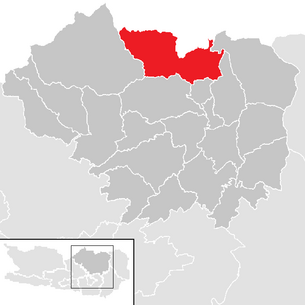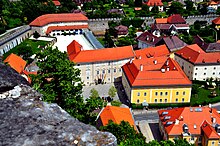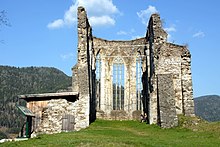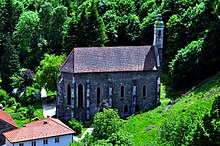Friesach (Carinthia)
|
Borough Friesach
|
||
|---|---|---|
| coat of arms | Austria map | |
|
|
||
| Basic data | ||
| Country: | Austria | |
| State : | Carinthia | |
| Political District : | Sankt Veit an der Glan | |
| License plate : | SV | |
| Surface: | 120.84 km² | |
| Coordinates : | 46 ° 57 ' N , 14 ° 25' E | |
| Height : | 634 m above sea level A. | |
| Residents : | 4,948 (January 1, 2020) | |
| Population density : | 41 inhabitants per km² | |
| Postal code : | 9360 | |
| Area code : | 0 42 68 | |
| Community code : | 2 05 05 | |
| NUTS region | AT213 | |
| Address of the municipal administration: |
Fürstenhofplatz 1 9360 Friesach |
|
| Website: | ||
| politics | ||
| Mayor : | Josef Kronlechner ( SPÖ ) | |
|
Municipal Council : ( 2015 ) (23 members) |
||
| Location of Friesach in the Sankt Veit an der Glan district | ||
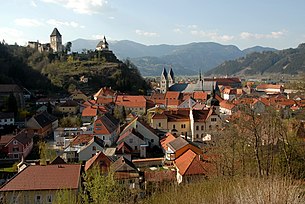 View from the Virgilienberg to the city center |
||
| Source: Municipal data from Statistics Austria | ||
Friesach ( Slovene : Breže ) is a municipality with 4948 inhabitants (as of January 1, 2020) in northern Carinthia . It is the oldest city in Carinthia and is known for its medieval buildings that are still well preserved today, such as the city fortifications and the water-bearing city moat.
geography
The city is located at the exit of the Metnitz Valley on the Friesacher Feld , at the foot of the Virgilienberg and the Petersberg. The foothills of the Gurktal Alps form the basis for the fortifications in the west.
The mouth of the Olsa is near Grafendorf .
climate
|
Average monthly temperatures and rainfall for Friesach
|
|||||||||||||||||||||||||||||||||||||||||||||||||||||||||||||||||||||||||||||||||||||||||||||||||||||||||||||||||||||||||||||||||||||||||||||||||||||||||||||||||||||||||
City structure
Friesach is divided into the three cadastral communities Friesach, St. Salvator and Zeltschach and includes the following 43 localities (population in brackets as of January 1st, 2020):
- Dobrich (13)
- Dörfl (17)
- Engelsdorf (377)
- Friesach (Breže) (1971)
- Gaisberg (81)
- Grafendorf (248)
- Guldendorf (5)
- Gundersdorf (5)
- Gunzenberg (9)
- Gwerz (52)
- Harold (19)
- Hartmannsdorf (19)
- Hundsdorf (4)
- Ingolsthal (101) including Roßbach
- Judendorf (63)
- Krauping (14)
- Leimersberg (11)
- Mayerhofen (7)
- Moserwinkl (23)
- Oberdorf I (24)
- Oberdorf II (14)
- Olsa (456)
- Pabenberg (44)
- Reisenberg (25)
- Rossbach (49)
- St. Johann (136)
- St. Salvator (522)
- St. Stefan (86)
- Saddle bow (12)
- Schratzbach (31)
- Torrent (49)
- Silbermann (18)
- Staudachhof (39)
- Stegsdorf (18)
- Timrian (14)
- Wagendorf (5)
- Catfish (6)
- Weighing (9)
- Meadows (12)
- Zeltschach (selce) (174)
- Zeltschachberg (19)
- Drawstring (128)
- Jewelry (19)
history
Silver and iron finds from the La Tène and Roman times in today's municipal area indicate that the area that the city occupies today was settled at an early age. The Roman imperial road Via Julia Augusta ran right through the middle of today's city: It ran from intermediate waters to Wildbad Einöd roughly along the current route of the B 317 .
Numerous place and river names testify to the settlement of the region by the Slavs in the late 6th century ; also Friesach is of Slavic BRÉZÉ derived (place to the Birch). The subjugation of the Karantan Slavs around 740 was followed by settlement by Bavarians , who came to Carinthia in particular via the Neumarkter Sattel . In and around Friesach a number of farms were built. In 860, Ludwig the German transferred several goods to the Archbishop of Salzburg, Adalwin , including the Hof ad Friesah (in front of Friesach), which is the oldest documented mention of the place.
Southeast of this court founded Count Wilhelm from 1016 to 1028 due to a King Konrad II. Conferred privilege a market which, however, about 100 years later, abandoned from 1124 to 1130.
Due to its favorable location on one of the main trade routes between Vienna and Venice , the market quickly rose to become an important trading center in the Middle Ages . The place was a main staging area in Italian traffic . In 1215 the market was elevated to the status of a city. Friesach experienced its heyday under Archbishop Eberhard II. (1200–1246) and developed into the second largest city of the Archbishopric of Salzburg and the most important city of today's Carinthia. The archbishops first minted the Friesacher Pfennig in 1130 , which remained a supra-regional means of payment as far as Eastern Hungary for over two centuries. The silver used in the mint was partly mined in the nearby tent chess .
Friesach was not only an economic, but also a religious center of that time. The Salzburg archbishops had a residence built in Friesach and numerous church orders also settled there. At the end of the 13th century, as a result of clashes between the Salzburg archbishops, the Habsburgs and Bohemia , the city was conquered, looted and destroyed by arson three times within a few decades. On March 20, 1292, the uprising of the Landsberg Confederation against Duke Albrecht I was temporarily ended by the settlement of Friesach in the Friesach Castle , after the town had been stormed and cremated by Albrecht's troops.
The city remained a part of the Prince Archbishopric of Salzburg until 1803, but lost its importance and could no longer build on the economic and cultural heyday of the Middle Ages.
Since Friesach was constituted as a political municipality in 1850, its scope has been changed several times. The cadastral community of Töschelsdorf (1873) as well as Zeltschach (1890) and Micheldorf (1892) split off from the original municipality . On the occasion of the municipal structural reform in 1973, the previously independent local parishes of St. Salvator , Zeltschach and Micheldorf were incorporated, the latter becoming independent again in 1992.
In the course of the emerging summer tourism in Carinthia, a beautification association was founded in Friesach in 1881 , one of the aims of which was to “prevent the destruction of ruins and the dragging of antiquities”. A sidewalk was built along Bahnhofstrasse, the Roman and Jewish stones scattered around the city were collected, park benches, tables and information boards were set up, and "Bengali lighting" was installed on the town square and the ruins. At the beginning of the 1890s a swimming pool was built, which was taken over by the club in 1900, further sporting activities followed with the establishment of tennis courts and the organization of excursions by the cycling club. This created important foundations for the tourist infrastructure in Friesach during this period.
The Carinthian Provincial Exhibition of 2001 under the motto Schauplatz Mittelalter showed the city in the Middle Ages as a central theme, which should bring about sustainable impulses for tourism. In May 2009 a construction site for a castle building project based on the model of Guédelon was ceremoniously opened on a hill in the south of the city. This project was intended to show how a castle could be built using medieval working methods. In 2011, however, the project organization was fundamentally changed, the keep that had begun was blown up for static reasons and the facility continued with a more tourist focus.
population
At the time of the 2001 census, Friesach had 5,462 inhabitants, 96.2% of whom are Austrian citizens. 89.8% of the population profess the Roman Catholic Church, 2.6% the Evangelical Church and 1.5% Islam . The Jehovah's Witnesses have a Kingdom Hall in Friesach. 4.8% of the population are without religious beliefs.
Population development

Economy and Infrastructure
Established businesses
Friesach has small and medium-sized companies in the metalworking and textile industries . The German Ordens Hospital and Carinthian Caritas facilities such as the Hemma House point to the importance of the social service sector. The urban area is characterized by a large number of small, tourism- oriented businesses.
traffic
The Friesacher Straße (B 317) runs in a north-south direction through the municipality and connects Friesach with the state capital in the south, 45 km away, and with Styria in the north. A state road branches off from it north of the city to the west, which leads through the Metnitztal .
The Friesach train station is located on the St. Michael – St. Veit / Glan of the Rudolfsbahn .
Education and Social
- Kindergarten: In the municipality of Friesach there are two groups of children and a parish kindergarten.
- Schools: The elementary schools in Friesach and St. Salvator as well as the new middle school provide for the education of the youth .
- Health: Several general practitioners and specialists are available to provide health care for the population. In Friesach there is a pharmacy and a hospital run by the Teutonic Order .
- Care: The Carinthian Caritas Association operates a care home in the city center.
Culture and sights

Buildings
- Petersberg Castle with a 28 m high keep
- City fortifications Friesach
- Geiersberg Castle
- Fürstenhof Friesach with historic granary
- Parish church Friesach
- Teutonic Order Church
- Dominican Church and Convent of the Dominicans
- City fountain Friesach
- Virgilienberg church ruins
- Heiligblutkirche Friesach (seminary church)
- Filial church of St. Peter
Hague Convention
The old town of Friesach is protected under the Hague Convention for the Protection of Cultural Property in the Event of Armed Conflict .
theatre
- Friesacher Burghofspiele (since 1950, at times as "Friesach Summer Games")
Museums
- City Museum on Petersberg
- Experience castle building Friesach
- Porsche Museum St. Salvator
- Wax Puller & Lebzelter Museum
Choirs
- Friesach Castle Choir
- MGV Friesach
- Rainbow choir tent chess
- St. Salvator singing group
- MGV Ingolsthal
- Border choir
music
- Music school Friesach
- City chapel Friesach
- Friesach Culture Forum
Personalities
- Karl von Friesach († 1260), Bishop of Lavant
- Almerich Grafendorfer (* before 1251; † 1267), Bishop of Lavant
- Gerold von Friesach († 1333), Bishop of Gurk
- Sigmund Bleibtreu (1819–1894), Hofburg actor, father of Hedwig Bleibtreu
- Hubert Hauser (1856–1913), businessman, founder of the city beautification association
- Nik P. (bourgeois Nikolaus Presnik, * 1962), pop singer and composer
- Josef Bucher (* 1965), politician (BZÖ)
- Andreas Thierry (* 1970), right-wing extremist politician and journalist
- Gerda Hofstätter (* 1971), pool player
- John Wray (writer) (born 1971), writer
- Christopher Hinterhuber (* 1973 in Klagenfurt , grew up in Friesach), pianist
- Willi Gabalier (* 1981), dancer
- Robert Stadlober (* 1982), actor, voice actor, musician and singer
- Andreas Gabalier (* 1984), singer
- Anja Stadlober (* 1984), actress and voice actress
- Nicole Schmidhofer (* 1989), ski racer
See also: List of Mayors of Friesach
politics
City Councilor and Mayor
The city council (city government) consists of six members. The directly elected mayor is Josef Kronlechner (SPÖ).
Municipal council
The municipal council consists of 23 members and has been composed as follows since the municipal council election in 2015 :
Twin cities
coat of arms
The coat of arms of Friesach is based on the oldest surviving seal on a document from 1265. It shows the Friesach city fortifications in a strongly stylized form with the Olsator in the middle, the Neumarkt and St. Veiter Tor on the sides, and the Rotturm at the back.
The official blazon of the coat of arms reads: “In red a city fortification forming a pentagon, which tapers down to a double-gate building with a button-crowned tent roof, encloses an equally covered tower on the right and left and surmounted by a large tin tower flanked by two small tin towers becomes."
The Friesach flag is red and white with an incorporated coat of arms.
panorama
literature
- Robert Gratzer: Friesach - the eventful history of an important city . Verlag Johannes Heyn, Klagenfurt 1986, ISBN 3-85366-484-9 .
- Peter Franz Hirner: State Exhibition Friesach 1999 - the city in the Middle Ages . Graz University of Technology (diploma thesis), 1994.
- The secular architectural and art monuments of the city of Friesach. Arranged by Barbara Kienzl , Gerhard Seebach, Ulrike Steiner. Schroll, Vienna 1991 (= Austrian Art Topography, Vol. LI).
- Heinrich Gressel: Friesach. Chronicle of the oldest city in Carinthia . Self-published, Klagenfurt 2008, ISBN 978-3-200-01169-4 .
Web links
- City of Friesach
- 20505 - Friesach (Carinthia). Community data, Statistics Austria .
Individual evidence
- ↑ a b Directory of place names ( memento of the original from December 21, 2014 in the Internet Archive ) Info: The archive link was inserted automatically and has not yet been checked. Please check the original and archive link according to the instructions and then remove this notice. (PDF; 146 kB), accessed February 27, 2014.
- ↑ Statistics Austria: Population on January 1st, 2020 by locality (area status on January 1st, 2020) , ( CSV )
- ↑ Hartwagner 1977, p. 50
- ↑ Dehio-Handbuch Kärnten, Vienna 2001, p. 151
- ^ Promotion of the influx of foreigners to Carinthia through associations in: Kärntner Gemeindeblatt No. 14/1881, p. 212–217, here: p. 215
- ^ Heidi Rogy: Tourism in Carinthia. Publishers of the history association for Carinthia, Klagenfurt 2002, p. 175 f.
- ^ Renate Jernej: The castle building in Friesach. The story and the end of an idea . In: Network History Austria. Annual publication 2014. Volume 3. Kirchham bei Vorchdorf 2014. ISBN 978-3-200-03639-0 . Pp. 20-26.
- ^ Municipal data, 2001 census
- ↑ City of Friesach, kindergartens. Retrieved June 23, 2019 .
- ^ City of Friesach, Education. Retrieved June 23, 2019 .
- ^ City of Friesach, Health, Doctors. Retrieved June 23, 2019 .
- ^ Hospital of the Teutonic Order in Friesach. Retrieved June 23, 2019 .
- ↑ Caritas Carinthia, Help & Advice, Care & Care, Nursing Homes. Retrieved June 23, 2019 .
- ^ Ensemble Friesach. Federal Monuments Office , accessed on June 19, 2017 (with marking of the protected area).
- ↑ Entry in aeiou
- ↑ Office of the Carinthian Provincial Government ( Memento of the original from November 18, 2015 in the Internet Archive ) Info: The archive link was automatically inserted and not yet checked. Please check the original and archive link according to the instructions and then remove this notice.
- ↑ Office of the Carinthian Provincial Government ( Memento of the original from May 25, 2015 in the Internet Archive ) Info: The archive link was inserted automatically and has not yet been checked. Please check the original and archive link according to the instructions and then remove this notice.
- ↑ Quoted from Wilhelm Deuer: The Carinthian municipal coat of arms . Verlag des Kärntner Landesarchiv, Klagenfurt 2006, ISBN 3-900531-64-1 , p. 106.


